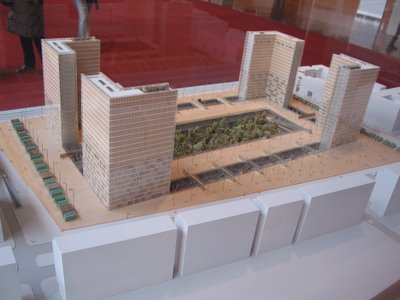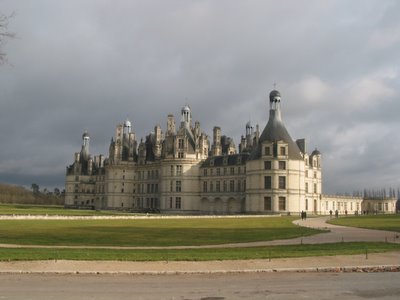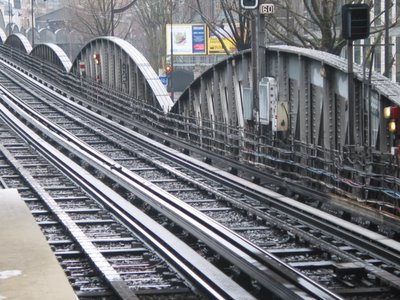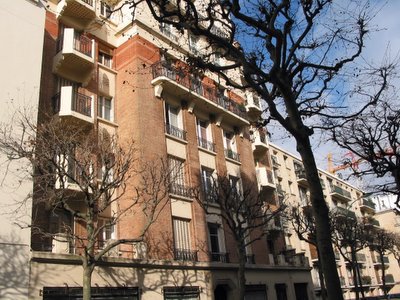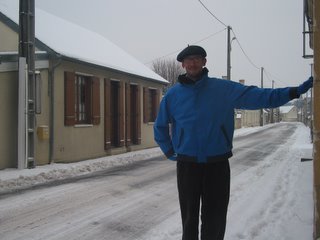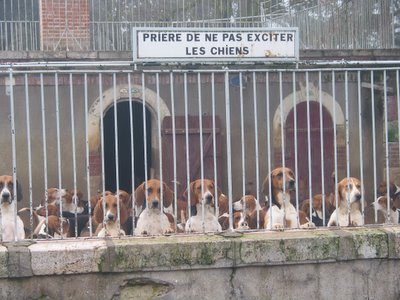France 2006
Saturday, February 25, 2006
Les égouts de Paris
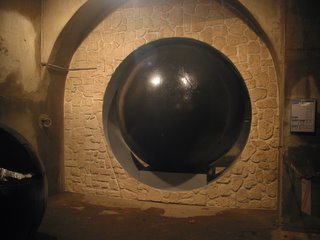
As I was skimming through Pariscope last week I came upon a section called “visites et promenades” and my eye stopped at a listing “Les égouts de Paris.” My antennae went up. I have at least mastered a few thousand French words over time and I did not immediately know what “égouts” might be. I knew the word for taste, “goût,” so I immediately extrapolated that perhaps égouts might mean “tastings.” The pseudo-gourmet in me came out at that moment. What could these tastings possibly be? Chocolate? Wine? A variety of unpasteurized country cheeses? Chocolate, wine, and a variety of unpasteurized country cheeses all at once? At that point it was Sunday, around lunchtime, and my morning gruel was but a distant memory and my rumbling stomach thought this was an excellent idea. The price was certainly a bargain, 4 euros, and the location, a few blocks from the Musée D’Orsay, was just two Métro lines away.
I readied myself to leave the apartment but just before I left I noticed my little anglais/français dictionary by the door and a nagging voice in my head said “look up égouts...”
Just like the Métro, the sewers of
However, the city population was still small enough that the
Under Napoleon III in the 1850s and 1860s, at the same time as builders redid the city streets and created new parks, other engineers began to build the first, true modern sewer system. In the span of some twenty years dozens of larger sewers ran under
The entrance to the “Égouts de Paris” is a rather undistinguished looking turret-shaped building, about the size of a large news kiosk. The sign has an “arrow” that points underground and one goes up to the turret/entrance (hardly on the same scale as I.M. Pei’s pyramid) and pays the four euros to a rather cheerful attendant (more on that later) and descends a spiral staircase around the turret to the bowels (sorry) of the city. It is a self-guided tour of a very small cross section of the sewers, several twists and turns and cavernous openings underneath the streets, perhaps a couple of hundred yards in length. And while it is a sewer, it is actually a storm sewer that one is touring and the only smell is that of rotting leaves (hey, what happened to the chocolate, wine, and variety of unpasteurized cheeses?). Outside, above ground, it was another chilly and gray day and the sewer was warm, though certainly on the humid side.
The tour leads through various cross sections of the sewer and is full of informative signs, a diorama or two, and just a few other tourists. A group of schoolchildren were behind me as I guided myself along the tour and they certainly seemed to be excited about the sewer. Perhaps I was missing something? Jean Valjean? The ghost of Baron Haussmann? Anton and his rooster, on the run? I paused and saw the children being led by a special guide, a sewer worker proudly wearing his powder-blue jumpsuit. I decided to draft behind the “tour” as it was not offered to the average tourist, even the specialist on French advertising history. The guide certainly knew his sewer stuff as he animatedly described parts of the sewer, its pipes, its cleaning and maintenance, and certainly everything else that one would want to know about the sewers. The children certainly seemed to be fascinated with his sewer lore. Of course, I recall my own interest in water at that age, of building dams and canals and channels in our family’s side yard and then turning on the water from a spigot to test the soundness of my construction. Perhaps that was my true calling? My vocabulary took a real boost that day as I learned all types of hydrographic words that I never otherwise would have come upon. Part of the tour took us on an iron grating, a sort of catwalk, that was above the rushing water below us and I felt myself being permeated by the essence of dead, moist leaves. I am sure there is some spa in the Western U.S. that offers the same treatment but here I was in
He took great delight in explaining one of the major problems of the storm sewers: the buildup of silt over time, that, if left untreated, would see the sewers arteriosclerotically blocked. The Parisian solution during the late 1800s was ingenious. Engineers constructed a large, hollow, floating metal ball that was eighty percent the diameter of the silted sewer. The ball would be lowered into the sewer in pushed into the opening. The ball in the sewer (think of a pea in a straw, perhaps) would let water flow around its sides. However, just like a plane wing creates lift because of the lessening of air pressure above the wing, the ball changes the water pressure in the pipe and causes the water to flow much more quickly around the ball creating turbulence. This turbulence put the silt back into solution and would see the problem solved.
The best part of the tour was the historical alleyway that consisted of a forty or so hanging placards, in both French and English, that gave a history of the sewer through text, maps, drawings, and pictures (most of which I cribbed for the introduction). With the water and debris rushing below I had a good half hour of learning everything and more about the sewers. At one point one could even take a tour of the sewers in a Venetian style gondola but those days have long ended? And, like all museums now, this “museum” had a gift shop that one had to enter before the final exit. While much of the exhibit was excellent one could say the gift shop needed some work, especially in their stock: a few pins, a postcard or two, a
A few television monitors were in the shop and one could chose to watch one of seven different three-minute programs about “Paris and its sewers today.” One included vignettes of Parisians losing their keys and other possessions down the sewers. The Parisians then called a special sewer hotline that appeared on the screen and the scene switched next to a special powder-blue van, a sewer response team of experts dressed in you-know-what that with the precision of a CSI team delved back into the depths and rescued those items to the grateful response of their owners. There certainly appears to be a sense of pride in the sewers that one does not see in the
One lonely attendant, in his powder-blue jumpsuit sat on a little stool by a cash register that got little use. The smell of rotting leaves was even stronger here as the gift shop was in a cul-de-sac of sorts that had little ventilation. The attendant did not look very happy (I am sure he knew the words to all of the incessantly-playing videos by heart) and I imagine his chief aim in life was to perhaps rise to the much happier ticket-taker above him if tuberculosis or consumption did not get to him first.
While not quite what I originally expected I found the diversion to be worthwhile. I have now witnessed the city’s two largest underground infrastructural achievements. All I now have left of this troika of the troglodyte world are the catacombs. But that awaits for another day and another blog.
Friday, February 17, 2006
Métro boulot, Métro dodo
This is a French idiomatic expression that one can translate as: Métro work, Métro sleep. Of course, to the average Parisian this encapsulates the banality of life. Five days a week they trudge out to their local stop in the morning, blearily ride the train (or series of trains) to work, push papers about in their cubicle (plus perhaps a few games of FreeCell), blearily take the train home, and then go to sleep. Repeat for about thirty years and then retire. I think Sartre had a word for this but I cannot recall it at the moment…
I, of course, after two weeks in
While generally an early riser in the States I have yet to master that skill here. Perhaps one reason is that the sunrise is about an hour later than for me at home and a second reason is that when the sun rises there is a thick layer of clouds shielding it. As a result, even by eight a.m. my bedroom is fairly dark when I finally get up. Since I am in charge of my own breakfasts I have moved from the Puissant all-bread breakfast back to my traditional gruel and I am out the door by a little after eight thirty. My Métro stop is just a three-minute walk from home and I take the stairs down to the station.
The world’s tallest cliché, the
I have always found the Métro to be easily accessible. The stations are usually close to the surface (unlike the
Moreover, I have the good fortune on living on the premier Métro line, the #1 (it goes along the Champs-Elysées, the Louvre, the Hotel de Ville, and a few blocks from Notre Dame). As a result, my trains are new and clean and also run quite often—usually at most I might have a three minute wait—which means not as much crowding. The new trains have no dividing doors between compartments so one can actually sit in the last train and seen eight to ten trains up to the front. At times it is almost a disconcerting sight as the trains snake through some twists and turns underground.
I board my train at Saint-Mandé and sit down. It is not a place to talk and meet people. Does one really want to tell a child some ten years later that “I met your mother on the subway”? It is also, thank goodness, not a place for cell phones and the most one hears is a few muted conversations. Most passengers take a defensive posture to ward off unwanted social contact. Everyone who rides the Métro wears some sort of mask. First, there’s the “reader,” who, now matter how much the train might lurch or if someone bumps into them will not move their book away from their face as their concentration is so intense. Second, there’s the “starer,” who stares at the map of the stops of the train and counts how many stops to go, even if the “starer” has taken the train for years and could ride the train, eyes closed, and know exactly the position and station. Third, there is the “defender” who sits with a bag or a sack or a purse enclosed by his or her crossed arms, legs tucked underneath the seat while wearing an airport scowl (thanks, Fred). The “defender” dares anyone and everyone to trespass upon his or her bubble. Last, there is the “continental.” The “continental” has done it all and seen it all and carries an air of world weariness.
Porte de Vincennes, Nation, and Reuilly-Diderot all go by. Ten minutes after I first boarded I get off at the next stop, the Gare de Lyon. Besides fourteen Métro lines that cover Paris like a lattice, Paris also has five train lines (the RER) that run deeper and faster underneath the city and also run well outside the city limits above ground to the suburbs and banlieues that surround it. The Gare de Lyon is a multi-train station that not only is a junction of three different Métro lines but it also houses two RER lines, the A and the D. As a result, I have a long walk from my line to the next Métro, the 14. These multi-line stations see thousands of commuters, all briskly pacing to their next stop through which, to the outsider, may seem like a rabbit’s warren of tunnels and corridors. These large stations also house shops, boutiques, cafés, and shops. One shop is called “Presty Woman” and sells women’s accessories. I do not really know what “Presty” means—it is not a French word that I know of and I suspect that it was supposed to read “Pretty Woman” but someone did not bother to proofread when the proper time came. Today, I do not stop at Presty Woman but continue on to the 14.
This is the newest line on the Métro, and also the shortest, a mere eight stops, created as a line that would lead to the new Bibliothèque Nationale. As a result, the trains, like the #1 line are new. However, not only are they new but this line has no drivers as the trains are automated. Normally, this would not bother me one way or another this day we were nearly at the BN when my train lurched to a stop, and I mean lurched, as some people on the train actually lost their footing and fell. While not especially paranoid about subways I did wonder what was going on. No one else seemed bothered so I kept my “continental” mask on. A minute later and automated voice came on stating that there had been a “technical accident” and that we should “be patient” until it was resolved. Since I had no intention of getting out of the train (and we were actually directly under the
I get off the train at my station and do my five-minute walk to the library for my usual processing before I can reach the bowels of the building and the thrill of French advertising trade journals of the 1950s. I am well into a routine as I go to the desk in my reading room and present my card to a clerk who then scans the card and then retreats to a back room to find the boxes of journals that I had requested the previous day. I return with my card and my boxes and begin a day’s work. I have a lot of reading to do and even if I cannot speak French particularly well I can scan in French very fast and I go through an edition of a journal in about fifteen minutes looking for the things historians look for…
I have a laptop (thanks, Joe!) and take notes from smaller sections of journals but occasionally I come to articles that are just too juicy and long for me to try to type out completely due to time constraints so I take my journal to the photocopying room. There are only two photocopying rooms for some few hundred readers and I am quite lucky that most other researchers are not copying much. With only two rooms for photocopying one has to hope when one gets one’s reader’s desk assigned that one is close to the copy room for one might have to walk as far as seventy yards to reach it. While that may not sound like that far to walk (for a marathoner, no less) it is not that convenient when I have to copy things about twelve different times during the day. Once I reach the room I hand my photocopy card, loaded for copies at forty cents a page to the copy attendant. The BN does not allow researchers to do their own photocopying so as to protect the materials, and of course, this adds another barrier to even wanting to get photocopying done.
Another impediment is that some of the photocopy attendants do not want to do any photocopying at all. I seem to have about a twenty-five percent chance of getting an attendant who will look at my journal and say that it is “too delicate” to copy and hand it back to me and shrug their shoulders. One attendant frowned when she looked at my journal and starting shaking her head as she began to inspect that issue to see if it were “copy-worthy.” As she inspected she also proceeded to break the spine of the journal and nearly tore some pages out and she summarized the whole experience with an “It is too fragile to copy” reply. On the wall of the copy room is a list of documents that the BN will not photocopy but as I look at the list if one held to it to the letter one could not copy anything at all.
Later that morning I brought another article and the attendant (I have christened him “Grizzly Adams” as he looks like a younger version of the 80s television bear-man) also frowned and without even inspecting the journal he said, “Sorry, I cannot copy this.” This particular article was ten pages and I knew that it was impossible for me to type the whole thing out in anything less than two hours. I am more resourceful than that so I walked many, many yards to the other photocopy room to find another more pliant attendant. I was in luck as there was a young woman in this room (they seem to rotate the photocopiers every two hours to other parts of the BN in other service positions) and I ask her in my most obsequious French if she could photocopy this very rugged and tough French journal. Of course, she does not care at all about the condition of the journal (and to be fair, it is in very good condition as it has probably only been handled about five times) and copies the article for me with a smile. Cha-ching for the BN, as they just earned four dollars for the right to photocopy for me “Dissemblances et similitude de six publicitaires.”
And so goes my usual day at the BN: reading, scanning, typing, and then running the obstacle course of the photocopy rooms. Grizzly
Thursday, February 16, 2006
Address
My address:
Hultquist
c/o Mouchnino
15 Rue Georges Huchon
94300 Vincennes
France
I would put up a mapquest map but I am out of time now...
Saturday, February 11, 2006
A Visit to Publicis
As you may have read in the previous entry my work on the history of French advertising agencies began in graduate school as it was my dissertation topic. Before I left for
A few others awaited for elevators and as we got in and pushed our floors I seemed to notice that when I pressed “six” that the others’ eyes seemed to scrutinize me a bit closer (they all pressed lesser floors, the dwellings of cubicle drones and lower middle managers) and wonder, at least so I thought, who I was. Publicis television commercials played in monitors above the number banks. The sixth floor had changed little from what I could recall at the last visit. Thick, cream-colored carpeting and dark black paneling with black leather chairs awaited me in the foyer with a podium at the end where I gave my name. I was asked to wait a moment and a few seconds later the Executive Vice President of Corporate Communications, Eve Magnan, came out to greet me. We exchanged the briefest of pleasantries and then went to the office of Bertrand Siguier, Vice-President of Publicis (and basically the number two man after Lévy at Publicis proper). Siguier, a trim and athletic man in his late fifties had actually been hired by Bleustein-Blanchet himself in the 1960s, and has worked his way up the corporate ladder.
Our discussion began in French but I noticed over time that we used French less and less and English more and more (as they politely realized the meeting would go faster that way). Both were quite interested in my project, though Siguier thought a better and more important story was the history of Publicis from 1969 to the present rather than my earlier period. Since he had been an important participant in that second period of expansion I could understand why. Unfortunately, nearly all my work and understanding of French advertising takes place before 1969 so I told him that could indeed be my next project. He nodded his acquiescence and then turned to look at the chapter I had mailed him. This particular chapter was a history of the firm, 1946-1969 that I had crafted from multiple sources and the loss of much blood from my forehead as it dripped on the keyboard some years ago. Some readers know that I am not prone to self-aggrandizement but Siguier actually told me that they were many things in this chapter that he did not know and that it was the best thing that he had read on the firm (to be fair, almost nothing has been written about the firm, save for sketchy journalistic overviews so it was not as if he had a lot to compare my work to).
Thursday, February 09, 2006
The Bibliothèque Nationale
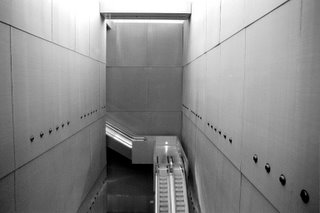 Photo courtesy J.R. McCain->
Photo courtesy J.R. McCain->And so my work begins.
French History>20thC
Of course, even advertising history is not the only thing I cover (for those of you who are bored--or my students Logan and Anthony--the page down button is to your right) for to understand advertising one has to understand the interrelated areas of the economy including the producers, the advertising agencies, the media, and the consumers. I am sure there is something else I am leaving out but you get the idea. Change fascinates me and it is no surprise that I became a historian as I like to try to understand how and why that change transpires.
For me, the best way to understand this era is not just by reading the advertisements, but I have to comprehend the agencies that created those advertisements. Just as an art historian must study an artist to understand the genesis of a painting I need to do the same thing with advertising. Who were these people? What was their background, training, and values? How did these attributes shape their advertisements?
So, where do I begin? My best sources are trade journals of the advertising profession. Nearly every profession produces trade journals and they are a rich source of information of the status of the trade. As a result, for the next several weeks I will be reading journals that I have read before in my last trip here, taking notes, photocopying, and improving upon what I collected in my first trip. Beyond that, I will be interviewing major actors in the French advertising profession (more on a later entry) for their own experiences.
These trade journals reside at the Bibliothèque Nationale de France (the “BN”). The BN is a venerable and nearly ancient institution, dating from the 13th Century, having originally been a royal depository. Now, like the Library of Congress, the BN is dedicated to collecting any document or book printed in French (and a number of other languages as well). The current collection is well over ten million books with countless other documents and other printed material. On my last research trip I did not use the old BN proper, at the Rue de Richelieu, but instead the BN Annexe near
In the fourteen-year gap since my last research trip the French government contracted for a new BN as the old facilities were, frankly, old. Space had also become a problem. The new BN was going to be a model for libraries of the future and also a cultural showpiece for
From a design standpoint the building is stunning (for a far better description, see the essay within the book Paris to the Moon by Adam Gopnik, staff writer for the New Yorker—thanks, Jim, for lending that to me). When one first approaches the BN from a distance one sees four twenty-five story towers (or ‘L’s) that appear like the legs of a table turned upside down. The upside-down table is on a platform of stairs that surround the building. As one takes the stairs up to a flat area (the underside, if you will, of the table top) one is in a flat, windswept plain with each tower a good two hundred yards or more apart. One certainly feels insignificant as a human considering the scale. In the center of the plain is a forest of pine trees that are recessed in a sunken garden, some eighty feet below the surface of the plain. As one strolls the plain of gray wooden planks one can just see the tips of the tallest trees emerging from the forest, perhaps the size of two football fields. To enter the library one has to take an escalator down to the garden level.
On my first day there last week I had to first obtain my “carte de recherche” allowing me access to the collections. Library bureaucrats subjected me to two levels of screening (no laughing, please) as I had to prove my academic bona fides to be allowed to use the collection. Honestly, I found the bureaucrats much more helpful and pleasant than the ones I encountered when I had my last screening as a graduate student. I guess having a Ph.D. and title of professor does open some doors.
During this initiation though, as usual, I found my reserves of French beginning to wear down. I think I have a French attention span of about ninety minutes. At minute 91 sharp those neurons go on strike (how French!). Various instructions came to me in French on the library’s use and rules (nothing in print) and as the interviews went on the French came faster and faster. Gopnik’s essay had warned me about the difficulty of use of the BN and suddenly it came to me that I barely had an idea of what the bureaucrats had told me. After going to the cashier to pay my $60 for my “carte de recherche” I decided it would be prudent to return to the library the next day when my reserves were replete.
The next day I returned and did what I do best: watch other people. When the library opened I went with other researches and stood in a line at a “vestiaire” where one exchanges their coats, bags, etcetera. One is given a clear plastic satchel in which one puts one’s laptop, books, notes, and other belongings (to help protect from theft) and then enters the beast. With your card you go through a turnstile and go through two steel double doors that would make a bank proud. From there one takes a double escalator down four floors in a large, airy corridor that is covered with steel-gray wall hangings (reminiscent of medieval chain mail) until one reaches the basement. I actually felt I was on my way to a place of ritualistic sacrifice as the ambiance was, to say the least, cold. One uses one’s card again to access another turnstile and then yet again two more steel doors. We are almost there! We are now at the true “garden level” and one can see the forest beside us enclosed in glass on its sides. On this garden level are different reading areas based on one’s area of research: law, economics, history, literature, philosophy, et cetera. There are 1650 reading seats. I made my way to the history section (though I actually could read in almost any section).
The desk had an outlet for my laptop (thanks, JP!), a light, and a large area for me to spread out my other materials. Perhaps it also has a nap area below: I shall check that out tomorrow and I shall get back with you. I went to the history desk close by and gave them my reader’s card and in return they found the materials that I had requested the day before. I returned to my desk, turned on my laptop, and began to read Vendre, January, 1946.
Wednesday, February 08, 2006
Monday, February 06, 2006
Sunday, February 05, 2006
I go to the Circus!
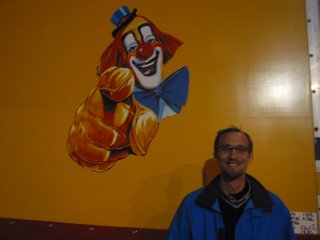
When I was writing a grant application for this trip I am sure one of the things I did not list on my research itinerary was a trip to the circus. But nonetheless, on my last night in
I am sure that the last time I attended the circus I was around five. About the only thing I recall was that I desperately wanted a toy sword that one of the vendors walking the stairs dangled in front of me. What a violent materialist I was then. So, as a point of Franco-American comparison, I would not really have much to go on save for snippets of televised circus I had seen. And, as a self-appointed cultural commentator, I realize that there is such a danger in making simplistic generalizations anyway (about either French or American culture) that one can Socratically dissect into non-truths. Certainly, after studying French history and culture for nearly twenty years I do have some authority and I have tried not to make my brushstrokes too broad.
The night of the circus the adults and four of the grandchildren crammed into two cars and we made our way to the “fairgrounds,” a parking lot next to
Madame Puissant had already bought the tickets for us, some family package deal that was very reasonably priced. As we approached the tent entrance Cirque Pinder employees dressed in hussar’s uniforms, red with gold stripes, greeted us and acted as ushers to take us to our seats. The big top itself was a “one-ring” circus with wooden planked banks of seats surrounding the ring. Each bank had about twenty rows and I could not imagine that the tent itself could hold more than a couple of thousand. This night it was about half full and we were most of the way up toward the tent wall. It scarcely mattered as our view was great. Half of the crowd was under ten and one could certainly feel their excitement as more people milled in and music played on the speakers.
Circuses certainly have a long history, dating at least back to
For a circus that was not particularly large (in terms of size or attendance) the Cirque Pinder put on quite a good show. The ringmaster was smooth and effortless in his delivery. All the performers were smartly dressed with a sense of flair. Trainers had groomed the performing animals little short of perfection. Between acts an army of helpers took apart and reassembled various apparatuses quietly and efficiently (with so many staff on hand I wondered how the Cirque could hope to turn even a slender profit). If I could make a guess, I would doubt that an American circus of similar size would pay such attention to detail. Of any of the performers, I would say that the “magicians” were clearly the best. Over the past years I have seen enough televised appearances of magicians and shows that reveal their “secrets” so there is not a lot new in terms of the basic magic act. However, even knowing what to look for I was dumbfounded for a few of their disappearing and reappearing acts and my applause for them was certainly genuine.
But then there is the sadness that is the circus. And this sadness is universal and knows no national boundaries…I just happened to be in
I also liked to watch the circus but not necessarily where I was supposed to be watching but instead I regarded the fringes, away from the center lights. Where can I start? Was it the fourth magician, dressed up like Michael Jackson, whose main task was to spin the various cages around but never was able to perform himself? Was it the women on the high wire who never actually went out on the wire but just brandished her arms like Vanna White as a Herve Villechaize look-a-like rode his Lilliputian bicycle back and forth fifty feet above the ground? Was it the slightly portly “acrobat” who had seen too many winters, a refugee of some 1980s Eastern European gymnastics factory who had been a great gymnast in his own right but never could quite perfect the triple twisting dismount from the rings (or whatever defining movement that was necessary to compete at the world-class level) hence dooming him to a circus career of one European city after another until his knees gave out forcing him into a new circus career of following the elephant with the poopscoop? Were their smiles really genuine?
Of course Vladu the gymnast could have similarly looked at me and pointed out my own shortcomings…if Hultquist had only been more assiduous in his own career he would be on his third book by now. And how could he give that three hundredth lecture on feudalism to a sleepy audience of indifferent freshmen?
But I save the best for last. The evening was over half over when into the ring pranced Anton Fischer and his “Tirolean” animal wagon. Fischer, a late forty-something combination of a dissolute Steve Martin and a manic Rod Stewart, danced and capered about the ring in his lederhosen, slapping his knees and the bottoms of his feet all the while grinning like there was no tomorrow. He was a great showman. Of course, he better have been one as his animal act was about as mundane as one could imagine. I actually took a video of this with my camera to verify I am not exaggerating-I may post at some point if I can solve some bandwidth issues. In his Tirolean wagon was a strange combination of animals that performed various tricks: a cat (don’t ask), a dog (don’t tell), a sheep (don’t go there), and a goat (please, Anton, for the love of God, stop). Of course, it was all very clean and family oriented, but seriously, does anyone really want to see a housecat poked and prodded into jumping through a hoop? And, having a cat stand atop a dog that is atop a goat that is atop a mule is not the most thrilling thing in the animal kingdom. Even some of the slower children in the audience realized that this was just filler until the next act and just applauded politely. Anton bounded off the stage, rooster in hand, to get ready for the next evening’s performance…
Saturday, February 04, 2006
Friday, February 03, 2006
Welcome to Paris!
Despite what you have read, gentle readers, over the past few weeks, I do pride myself on a certain level of competency in life. Certainly, this trip has tried and tested that pride on a number of occasions…
Wednesday, 1 February was the big day: the move to
This time I had no desire to try to find something on the fly. In late November, working through collegial connections I arranged an apartment just to the east of
I had my usual breakfast with the Puissant family and my two fellow students and at 9:30 Monsieur Puissant helped me load my suitcase in his car and I bade a sad goodbye to Madame Puissant and the household-she invited me to come back on any week-end that I wished during my remaining stay in France. I had a rather civil departure time of 10:30 from the
I was in no particular hurry that morning and I actually like taking the train at a more sedate pace through the countryside. French trains are not only comfortable but roll smoothly and have large windows perfect for watching the world go by. Besides, I had already taken the TGV to
About thirty miles from
A little before 1 p.m. the train pulled into the Gare de Austerlitz, one of the six Parisian train stations. I pulled my rolling suitcase from the train and made my way to the street. Metro lines run below all train stations in
Then, things started to go not quite as well. As the cab sped away on the busy Avenue de Paris I opened the agency’s door. The door that would not open. A tiny, handwritten sign said: out to lunch, back at 2:00. I ruefully looked at my watch and it was scarcely after 1:15. So much for my planning and my fine timing. Of course there could be worse things than to have to wander around
Of course, my apartment building was all of three blocks away, and even walking slowly this only took me about six minutes. The neighborhood, at least, was pleasant, a solidly residential area of mostly five-to-eight story apartment buildings. No signs of cars having been on fire anywhere! My apartment was scarcely a block from a large day care center (called a maternelle in
I did one more circuit as I did not want to just stand outside the agency on the street with passersby bumping into me…at 2:15 I returned and there was a light on inside. I happily entered and was greeted by a woman behind the desk. I explained my situation: the owner of the apartment had left the key for me to pick up today for the apartment. The woman’s reaction: I don’t know what you are talking about. My head began a legitimate pounding at this point. I had the phone number of my colleague’s friend in
Then the women said, “I’ll check with my colleague.” At least my French training was paying off as I could understand her. She returned in a moment and said, thankfully, “Oh, yes, we have your key here.” Sweeter words have rarely been spoken to me. She handed me an envelope (now this was ridiculously easy—she did not ask for my passport or name but just handed me the keys to someone’s place) and smiled. The throbbing began to reside. Of course, it was a quick walk to the apartment (I am sure some resident snoop who spends his/her day looking out their window wondered who in the world I was on my fourth circuit of the neighborhood) and I entered the number code I had been given into the exterior door. The door opened. So far, so good.
The owner had emailed me in the previous week—go to the second floor and to the first door on your left as her apartment. Parisian apartments typically do not have numbers, names, or any sort of identification on them. Most likely a sign of the privacy people wish in a large city. I took the incredibly tiny elevator (about as large as a phone booth) up one flight as I did not want to wrestle my bag up the stair. There were three doors to choose from and I chose the one of the left. I opened up the envelope the agency gave me and inside there were three oddly shaped keys that looked little different than medieval tools of dentistry.
Then, three of my remaining brain cells recalled one of the most basic things of French civilization: the first floor to them is our second floor. I had been trying for five minutes to open up the wrong apartment. I can only imagine if someone had been in there hearing me try to hack away (of course, maybe they are still there, paralyzed with fear at the attempted break-in). I turned from the door and walked up the stairs with a breathless silence that would have impressed a wraith. The stairs did not even creak.
I came to “my” door that only had one key and opened up the door with no problem. I was home. Certainly, I would have to say that I am pleased with my apartment. It has one bedroom, a living room, a small galley kitchen, and hardwood floors. While spartanly furnished, it certainly has enough for my simple needs. The owner has also left behind a collection of some hundred books in both English and French for me to read. I’ve been here for two days and I have found it to be pretty quiet. I do not have much of a view as my apartment looks over an interior courtyard and the matching rear of a similar building. It certainly has some quirks (not very many lights, no oven, no television, and a stereo that does not work) but I was able to get situated and figure out how to turn on the gas to the stove and turn on the electricity. Maybe I was not so incompetent after all.
